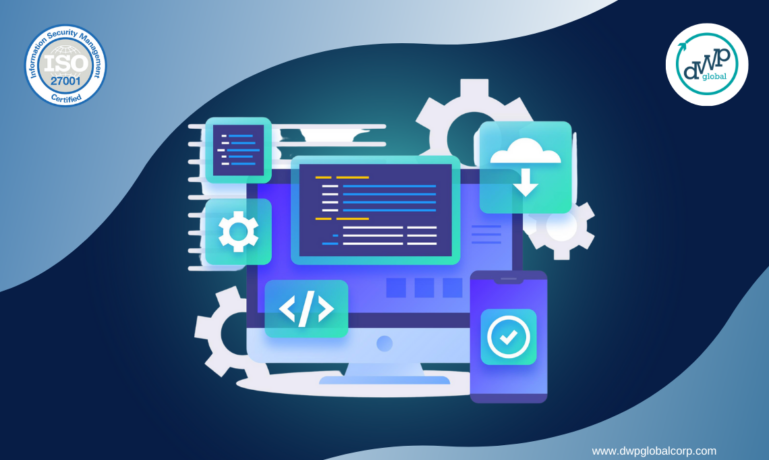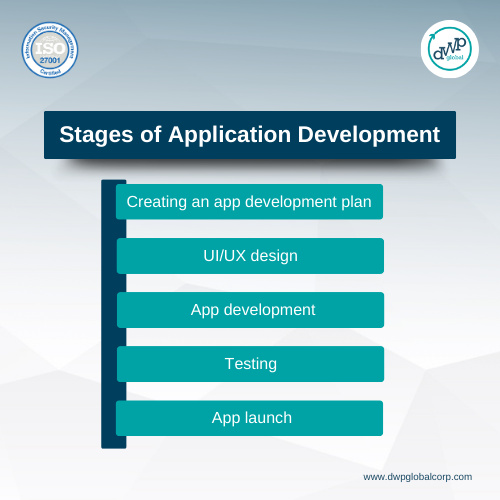- By: Admin
- August 11, 2023
- 1923 views

Developing a mobile app follows a standard and clear process involving strategy, design, development, and deployment, much like any other software development project. Specifically, the mobile app development process involves six fundamental stages: strategy, analysis and planning, design, development phases, testing, and deployment.
The best mobile app development company assists in the proper execution through their app development team.
Key Stages Of The Application Development Process
A successful mobile app development process needs a full developer account and a well-defined strategy.
Stage 1: Creating an app development plan
When clients come up with app ideas, they present them to developers to bring the app idea to life and market. Web application development companies may also provide suggestions and key performance indicators for enhancements.
When developing a mobile app, it’s important to analyze competitors to improve your app. When collaborating with an app development company, consider project goals, target audience, finances, timeline, and post-launch assistance.
Stage 2: User interface or User experience design
When developing a mobile app, it is important to prioritize user interface (UI) and user experience (UX) design to ensure a simple and user-friendly interface. A visually appealing appearance and seamless user interaction can attract potential customers, while errors in this stage can drive them away. So, one must work on the following areas:
- Workflows and information architecture
Planning an app’s features and user interface is crucial while developing it. It’s vital to consider platform interactions, such as adding the system clock to a scheduling tool. The mobile app development lifecycle procedures and the information architecture should be considered while making decisions. - Wireframes
When designing a mobile app, wireframes are created as digital sketches to plan the app’s functionality, placement of UI elements, and aesthetic appearance. It’s crucial to consider the multiple mobile devices on which the app will be installed to ensure a user-friendly experience on any mobile device or platform. - Prototypes
Prototypes are motion designs that simulate user experience and are essential for app testing. They’re time-consuming but necessary for successful app development. Popular prototyping tools include Balsamiq, Figma, and InVision. - Style guide
Regarding app design, having a style guide is crucial for font, color, and branding consistency. By selecting and approving a guide at the outset, you can increase productivity and give your mobile app design a cohesive look. It’s also important to consider platform guidelines like those provided by Apple and Google Play. - Mock Product
Mockups represent your app’s ultimate design realization, combining wireframes and the style guide. With mockups, you see how your mobile app development company will appear to its prospective users.

Stage 3: App development
Developing an app involves various complex stages, such as coding, testing, and creating an installation-ready product. This process consists of three parts – back-end/server technology stack, APIs, and mobile frontend development.
- Back-end/server technology
Creating server-side objects and setting up the database is the first step in ensuring proper app functionality. Modifications may be needed if utilizing an existing back-end platform. Customize and test server-side objects with other app components. - Application Programming Interface (API)
API is a software component of mobile applications that connects the app to the back-end server and other operating system components. - Mobile frond-end
The front end is the user-facing aspect of your application. Mobile apps typically utilize back-end APIs to manage data and provide interactive user experiences. However, mobile app designers deployed by Web development companies can utilize internal data storage in specific scenarios, such as when offline maps or services are necessary. - Programming languages
When selecting a programming language for an app, various development companies have varying considerations. One crucial factor is that the language should have support for server technology.For native mobile apps, the decision is more complex, as developers must choose from recommended technology stacks such as Kotlin for Android apps and Swift for iOS. Typically for cross-platform mobile apps, multiple languages and technology stacks can work for an app, and the developers must choose the most appropriate one. - Agile project management
The pace of the mobile app industry and technology advancement is remarkable, as new versions of mobile OS platforms are introduced every few months. Additionally, new mobile devices frequently arrive on the market. Most app development companies employ an agile approach to keep up with these changes.
An expert software development company guides businesses carefully through these steps.
Stage 4: Testing
Testing the mobile app is as important as developing it. It can even be more important — let’s see why.
- Quality Assurance (QA)
Quality assurance testing during mobile application development ensures app stability, usability, and security. - Functional testing
Mobile app development companies conduct rigorous testing to ensure optimal performance. Despite this, individual reactions may vary and could result in unexpected bugs. By conducting thorough testing, app developers can detect and resolve these issues before they impact users. - Security testing
Ensuring security during the mobile development process is paramount. Any errors can result in hacking or data breaches, so companies take measures such as testing data entry forms and incorporating additional security features for payment apps, such as two-factor authentication. - Device and platform testing
With the constant influx of new mobiles and operating system updates flooding the market, mobile app testing on all existing mobile devices can be complex. However, it’s important not to overlook the crucial aspect of mobile application testing on iOS and Android platforms.Other than the above, performance and user testing are also performed in the test-driven development approach.
Stage 5: App launch
Before releasing an app, it is important to ensure its details are accurate and up-to-date, including its title, description, category, icon, keywords, and app store screenshots. The App Store review process and optimization take weeks, while the Play Store review process takes only a few hours. Last but not least, app maintenance and service support stages.
DWP Global Corp As App Developers
DWP Global Corp is dedicated to building mobile apps that meet the business’s unique needs. They develop innovative solutions incorporating the best approaches to every application development and lifecycle aspect, from integration to maintenance. Whether you need a consumer-focused app, software development kits, or a game-changing enterprise-class solution, DWP Global Corp manages every step of the development process, from conception to delivery and ongoing support.
